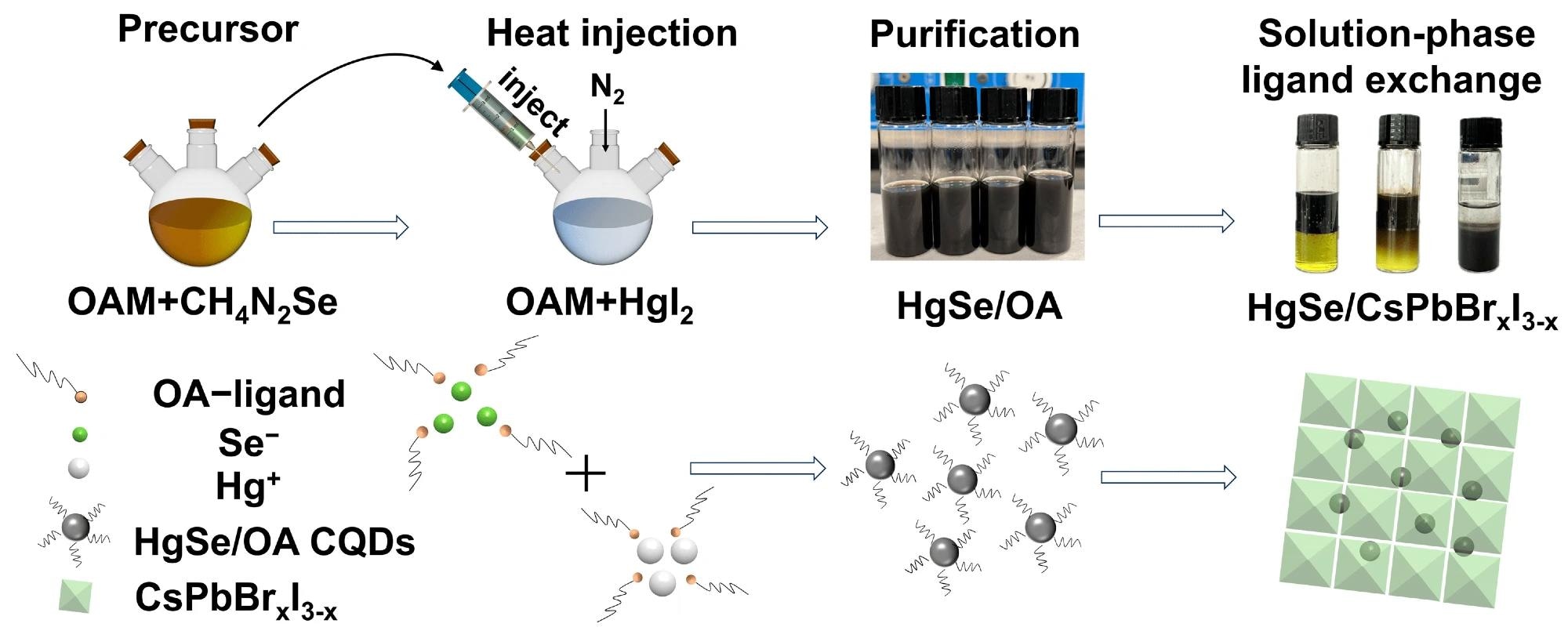A paper recently published in the journal Materials has proposed a groundbreaking method for constructing colloidal quantum dot (CQD)-based heterojunctions with remarkable efficiency. This innovative approach has led to the development of a high-performance photodetector utilizing a CQD heterojunction film.
 Schematic diagram of HgSe quantum dot synthesis and solution-phase ligand exchange. Image Credit: https://www.mdpi.com/1996-1944/17/8/1864
Schematic diagram of HgSe quantum dot synthesis and solution-phase ligand exchange. Image Credit: https://www.mdpi.com/1996-1944/17/8/1864
CQD-based Heterojunction Construction Challenges
Heterojunction semiconductors are widely employed in various active optoelectronic devices due to their distinctive capabilities in redistributing and regulating carriers. Each step of heterostructuring can follow a specific mechanism, such as induced fusion, phase segregation, partial ion-exchange conversion, and epitaxial deposition, contingent upon prevailing conditions.
However, limitations still exist due to the lattice matching problems among heterogeneous materials and poor stability of nanomaterials having large specific surface areas. Thus, constructing heterojunctions using nanomaterials that display pronounced quantum effects, like QDs, is a significant challenge, which limits their use in integrated optoelectronic devices, such as photodetectors and solar cells.
Specifically, exchanging the surface ligand for a heterointerface formation on a small surface area is more difficult for QDs with 2-20 nm diameters. Thus, developing innovative and efficient methods is crucial to solving the nanoscale semiconductor heterojunction problems.
The surfaces of CQDs synthesized using organic media are adorned with long, extensive carbon chain ligands, including tributyl phosphate, oleylamine, and oleic acid, which significantly hinder the transport of charge carriers within films, resulting in a reduction in QD optoelectronic device efficiency.
The electrical properties can be improved by modifying the CQD surface. Ligand exchange is an efficient strategy for surface modification of CQDs. This method passivates the surface defects for suppressing carrier recombination. Solution-phase ligand exchange with inorganics as a ligand candidate can offer an efficient and simple modification strategy.
The New Construction Approach
In this study, mercury selenide (HgSe) CQDs with monodispersion and oleylamine ligands were synthesized using the hot injection method. Subsequently, the HgSe CQDs were mixed with cesium lead bromide iodide (CsPbBrxI3-x) halide perovskite solution in precise ratios to obtain the HgSe/CsPbBrxI3-x heterostructure.
Finally, a photoconductive detector was successfully created using the HgSe/CsPbBrxI3-x heterojunction. The goal of this research was to establish a practical method for building heterojunctions with colloidal quantum dots (CQDs) and to enhance photodetector performance by employing CQD heterojunction films
Red mercuric iodide, selenourea, lead bromide, lead iodide, cesium iodide, N, N-dimethylformamide (DMF), oleylamine, and hexyl hydride were used as the starting materials for the study. Initially, selenium and mercury were dissolved in oleylamine to prepare the precursors.
Then, the selenium precursor was cooled to ambient conditions while the temperature of the mercury precursor was retained at 115 °C. Finally, the selenium was introduced gradually into the mercury solution to obtain HgSe CQDs. All synthesized CQDs were stored meticulously in a nitrogen-purged glove box.
HgSe CQDs purified through centrifugation and extraction were used with CsPbBrxI3-x solution to obtain the HgSe/CsPbBrxI3−x heterostructure during the solution-phase ligand exchange procedure. This procedure was performed under solution-phase conditions within a glove box. Researchers prepared the ion exchange solution through the dissolution of lead bromide, cesium iodide, and lead iodide in DMF.
A CQD solution in octane was mixed with the exchange solution, and the as-obtained mixture was agitated vigorously for 120 seconds to ensure complete CQD transfer to the DMF phase. Eventually, toluene was added to the resultant mixture, which was followed by centrifugation to obtain the HgSe/CsPbBrxI3-x heterostructures.
The photoconductive device/photoconductive detector was fabricated to evaluate the HgSe CQDs’ photoelectric properties at their characteristic wavelengths. Field emission scanning electron microscopy (FE-SEM), X-ray diffraction (XRD), ultraviolet photoelectron spectroscopy (UPS), and transmission electron microscopy (TEM) were used for characterizations.
Significance of the Study
HgSe CQDs with oleylamine ligands and a uniform size were synthesized successfully using the hot injection method. The oleylamine ligands on the QDs were exchanged effectively to acquire a compact and smooth CQD film using a halide perovskite precursor solution. The average diameter of the synthesized HgSe CQDs was 4.42 ± 0.16 nm.
HgSe/CsPbBrxI3-x heterojunctions with type I band alignment were acquired, which were obtained from the minor lattice mismatching of 1.5 % between HgSe and CsPbBrxI3-x through tuning the ratio of bromide and iodide in the halide perovskite. The band arrangement was determined as type I based on the infrared absorption spectra and UPS analysis.
Additionally, the HgSe/CsPbBrxI3-x heterojunction-based photoconductive detector displayed a distinct photoelectric response under 630 nm incident light. Effective recombination of photogenerated carriers was also confirmed using this device.
To summarize, the findings of this study demonstrated the feasibility of the proposed QD-based heterojunction construction strategy that simultaneously achieves inorganic ligand exchange. This paves the way for developing high-performance photodetectors that utilize QD heterojunction films.
Journal Reference
Yu, C., Shan, Y., Zhu, J., Sun, D., Zheng, X., Zhang, N., Hou, J., Fang, Y., Dai, N., Liu, Y. (2024). Heterojunctions of Mercury Selenide Quantum Dots and Halide Perovskites with High Lattice Matching and Their Photodetection Properties. Materials, 17(8), 1864. https://doi.org/10.3390/ma17081864, https://www.mdpi.com/1996-1944/17/8/1864
Disclaimer: The views expressed here are those of the author expressed in their private capacity and do not necessarily represent the views of AZoM.com Limited T/A AZoNetwork the owner and operator of this website. This disclaimer forms part of the Terms and conditions of use of this website.
Article Revisions
- May 8 2024 - Title changed from "Colloidal QD Heterojunctions for High-Performance Photodetectors" to "New Approach for Constructing Colloidal Quantum Dot-Based Heterojunctions"